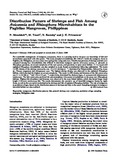Distribution pattern of shrimps and fish among Avicennia and Rhizophora microhabitats in the Pagbilao mangroves, Philippines
- Global styles
- MLA
- Vancouver
- Elsevier - Harvard
- APA
- Help

ดู/
วันที่
1999Page views
2,395ASFA keyword
AGROVOC keyword
Taxonomic term
เมตาดาต้า
แสดงระเบียนรายการเต็ม
Share
นามธรรม
For sustainable management of mangrove ecosystems, there is a pressing need to increase our knowledge of fish and invertebrates associated with this system. This study sampled microhabitats (89–258 m2) inside the mangrove forest at Pagbilao, the Philippines, on two consecutive spring tides using stake nets. Distribution patterns of shrimps and fish were compared among four microhabitats that differed in dominant mangrove species (Avicennia marina, A. officinalis or Rhizophora apiculata), structural complexity of the root system, and proximity to open water habitat. A 5 to 6-year-old replanted Rhizophora microhabitat was also sampled to study faunal recolonization following replantation. The mean (±SE) density of the shrimp community was 1·5±0·2 shrimps m−2, dominated by Palaemonidae, followed by Acetes sp., Penaeus merguiensis and Metapenaeus ensis . The highest shrimp density was observed in the replanted Rhizophora habitat, which also had the highest structural complexity. The mean (±SE) density and biomass of the fish community was 5·1±2·0 fish m−2and 10·4±3·3 g m−2, respectively, dominated by Ambassis kopsi, A. urotaenia and Atherinomorus balabacensis. The fish community preferred the pneumatophore (Avicennia) microhabitats to the prop root (Rhizophora) habitats. Highest fish abundance and biomass were observed in the most inland habitat, which also lacked larger (total length >100 mm) carnivorous fish. The results demonstrate the extensive use of intertidal mangrove forests by vagile fauna, as well as the successful recolonization by shrimps and fish of replanted Rhizophora habitat. The role of mangroves as predation refuges, based on the distribution pattern of shrimps and fish, is discussed. Sampling strategies in mangrove intertidal habitat are also outlined.
การอ้างอิง
Rönnbäck, P., Troell, M., Kautsky, N., & Primavera, J. (1999). Distribution pattern of shrimps and fish among Avicennia and Rhizophora microhabitats in the Pagbilao mangroves, Philippines. Estuarine, Coastal and Shelf Science , 48(2), 223-234. https://doi.org/10.1006/ecss.1998.0415
Type
ArticleISSN
0272-7714คอลเลกชัน
- Journal Articles [1256]
Related items
Showing items related by title, author, creator and subject.
-
Mangroves and community aquaculture
ผู้แต่งที่ไม่รู้จัก (Aquaculture Department, Southeast Asian Fisheries Development Center, 2000)Describes the efforts of AQD to raise mudcrab in pens in mangrove areas in Palawan and Aklan with the participation of local communities. -
Field guide to Philippine mangroves
Awareness of mangrove importance, particularly for coastal protection, has grown among the general public over the past several years. In turn, this has led to numerous planting initiatives by various groups. However, most ... -
Philippine mangroves: status, threats and sustainable development
The status of the Philippine mangroves is examined, the functions of mangrove areas are highlighted, the threats to mangrove resources are identified, and the prospects for sustainable use are discussed. The Philippines ...






